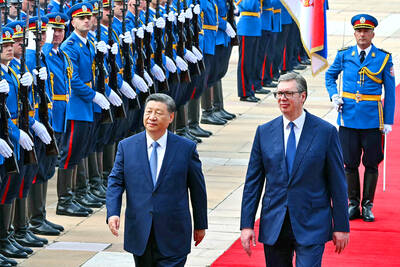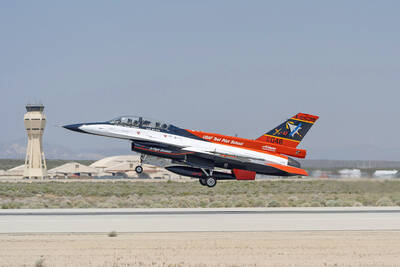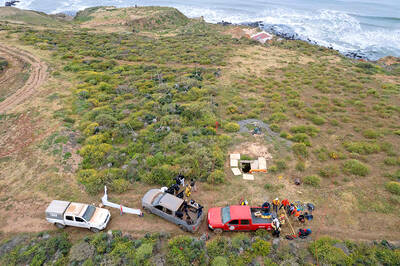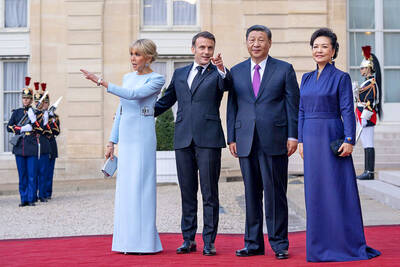A boyish-looking US diplomat was meeting for the first time with the Islamist leaders of eastern Libya’s most formidable militias.
It was Sept. 9 last year. Gathered on folding chairs in a banquet hall by the Mediterranean, the Libyans warned of rising threats against Americans from extremists in Benghazi. One militia leader, with a long beard and mismatched military fatigues, mentioned time in exile in Afghanistan. A US guard discreetly touched his gun.
“Since Benghazi isn’t safe, it is better for you to leave now,” Mohamed al-Gharabi, leader of the Rafallah al-Sehati Brigade, recalled telling the Americans. “I specifically told the Americans myself that we hoped that they would leave Benghazi as soon as possible.”
Yet as the militiamen snacked on Twinkie-style cakes with their US guests, they also gushed about their gratitude for US President Barack Obama’s support in their uprising against former Libyan leader Muammar Qaddafi. They emphasized that they wanted to build a partnership with the US, especially in the form of more investment.
The diplomat, David McFarland, a former congressional aide who had never before met with a Libyan militia leader, left feeling agitated, according to colleagues, but the meeting did not shake his faith in the prospects for deeper involvement in Libya. Two days later, he summarized the meeting in a cable to Washington, describing a mixed message from the militia leaders.
Despite “growing problems with security,” he wrote, the fighters wanted the US to become more engaged “by ‘pressuring’ American businesses to invest in Benghazi.”
The cable, dated Sept. 11 last year, was sent over the name of McFarland’s boss, then-ambassador to Libya Christopher Stevens. Later that day, Stevens was dead, killed with three other Americans in Benghazi in the most significant attack on US property since Sept. 11, 2001.
Months of investigation by the New York Times, centered on extensive interviews with Libyans in Benghazi who had direct knowledge of the attack there and its context, turned up no evidence that al-Qaeda or other international terrorist groups had any role in the assault. The attack was led, instead, by fighters who had benefited directly from NATO’s extensive air power and logistics support during the uprising against Qaddafi. And contrary to claims by some members of Congress, it was fueled in large part by anger at a US-made video denigrating Islam.
A fuller accounting of the attacks suggests lessons for the US that go well beyond Libya. It shows the risks of expecting US aid in a time of desperation to buy durable loyalty, and the difficulty of discerning friends from allies of convenience in a culture shaped by decades of anti-Western sentiment. The attack also suggests that, as the threats from local militants around the region have multiplied, an intensive focus on combating al-Qaeda may distract from safeguarding US interests.
In this case, a central figure in the attack was an eccentric, malcontent militia leader, Ahmed Abu Khattala, according to numerous Libyans present at the time. US officials briefed on the criminal investigation into the killings call him a prime suspect. Abu Khattala declared openly and often that he placed the US not far behind Qaddafi on his list of infidel enemies. However, he had no known affiliations with terrorist groups and he had escaped scrutiny from the 20-person CIA station in Benghazi that was set up to monitor the local situation. He denies participating in the attack.
Fifteen months after Stevens’ death, the question of responsibility remains a searing issue in Washington, framed by two contradictory story lines.
One has it that the video, which was posted on YouTube, inspired spontaneous street protests that got out of hand. This version, based on early intelligence reports, was initially offered publicly by Susan Rice, who is now Obama’s national security adviser.
The other, favored by Republicans, holds that Stevens died in a carefully planned assault by al-Qaeda to mark the anniversary of its strike on the US 11 years before. Republicans have accused the Obama administration of covering up evidence of al-Qaeda’s role to avoid undermining the president’s claim that the group has been decimated.
The investigation by the Times shows that the reality in Benghazi was different and murkier than either of those story lines suggests. Benghazi was not infiltrated by al-Qaeda, but nonetheless contained grave local threats to US interests. The attack does not appear to have been meticulously planned, but neither was it spontaneous or without warning signs.
Anger at the video motivated the initial attack. Dozens of others joined in, some of them provoked by the video and others responding to fast-spreading false rumors that guards inside the US compound had shot Libyan protesters. Looters and arsonists, without any sign of a plan, were the ones who ravaged the compound after the initial attack.
Much of the debate about Benghazi in Washington has revolved around statements made four days later in television interviews by Rice, who was then ambassador to the UN.
“What happened in Benghazi was in fact initially a spontaneous reaction to what had just transpired hours before in Cairo,” she said on NBC’s Meet the Press, “almost a copycat of the demonstrations against our facility in Cairo, prompted by the video.”
Republicans, pouncing on the misstatement, have argued that the Obama administration was trying to cover up al-Qaeda’s role.
“It was very clear to the individuals on the ground that this was an al-Qaeda-led event,” Republican Representative Mike Rogers, chairman of the House of Representatives Intelligence Committee, said last month on Fox News.
However, the Republican arguments appear to conflate purely local extremist groups like Ansar al-Shariah with al-Qaeda’s international terrorist network.

MONEY MATTERS: Xi was to highlight projects such as a new high-speed railway between Belgrade and Budapest, as Serbia is entirely open to Chinese trade and investment Serbian President Aleksandar Vucic yesterday said that “Taiwan is China” as he made a speech welcoming Chinese President Xi Jinping (習近平) to Belgrade, state broadcaster Radio Television of Serbia (RTS) said. “We have a clear and simple position regarding Chinese territorial integrity,” he told a crowd outside the government offices while Xi applauded him. “Yes, Taiwan is China.” Xi landed in Belgrade on Tuesday night on the second leg of his European tour, and was greeted by Vucic and most government ministers. Xi had just completed a two-day trip to France, where he held talks with French President Emmanuel Macron as the

With the midday sun blazing, an experimental orange and white F-16 fighter jet launched with a familiar roar that is a hallmark of US airpower, but the aerial combat that followed was unlike any other: This F-16 was controlled by artificial intelligence (AI), not a human pilot, and riding in the front seat was US Secretary of the Air Force Frank Kendall. AI marks one of the biggest advances in military aviation since the introduction of stealth in the early 1990s, and the US Air Force has aggressively leaned in. Even though the technology is not fully developed, the service is planning

INTERNATIONAL PROBE: Australian and US authorities were helping coordinate the investigation of the case, which follows the 2015 murder of Australian surfers in Mexico Three bodies were found in Mexico’s Baja California state, the FBI said on Friday, days after two Australians and an American went missing during a surfing trip in an area hit by cartel violence. Authorities used a pulley system to hoist what appeared to be lifeless bodies covered in mud from a shaft on a cliff high above the Pacific. “We confirm there were three individuals found deceased in Santo Tomas, Baja California,” a statement from the FBI’s office in San Diego, California, said without providing the identities of the victims. Australian brothers Jake and Callum Robinson and their American friend Jack Carter

CUSTOMS DUTIES: France’s cognac industry was closely watching the talks, fearing that an anti-dumping investigation opened by China is retaliation for trade tensions French President Emmanuel Macron yesterday hosted Chinese President Xi Jinping (習近平) at one of his beloved childhood haunts in the Pyrenees, seeking to press a message to Beijing not to support Russia’s war against Ukraine and to accept fairer trade. The first day of Xi’s state visit to France, his first to Europe since 2019, saw respectful, but sometimes robust exchanges between the two men during a succession of talks on Monday. Macron, joined initially by EU Commission President Ursula von der Leyen, urged Xi not to allow the export of any technology that could be used by Russia in its invasion